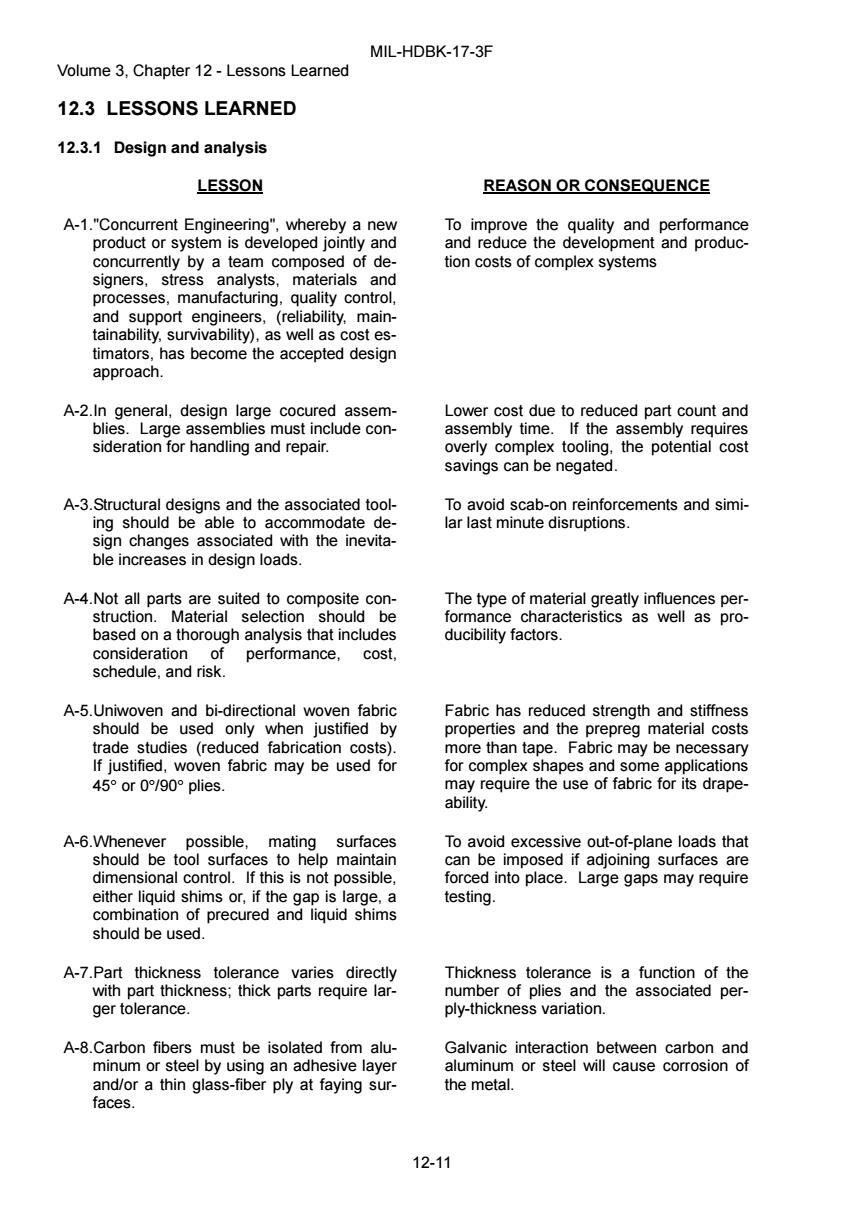正在加载图片...

MIL-HDBK-17-3F Volume 3,Chapter 12-Lessons Learned 12.3 LESSONS LEARNED 12.3.1 Design and analysis LESSON REASON OR CONSEQUENCE A-1."Concurrent Engineering",whereby a new To improve the quality and performance product or system is developed jointly and and reduce the development and produc- concurrently by a team composed of de- tion costs of complex systems signers,stress analysts,materials and processes,manufacturing,quality control, and support engineers,(reliability.main- tainability,survivability),as well as cost es- timators,has become the accepted design approach. A-2.In general,design large cocured assem- Lower cost due to reduced part count and blies.Large assemblies must include con- assembly time.If the assembly requires sideration for handling and repair. overly complex tooling.the potential cost savings can be negated. A-3.Structural designs and the associated tool- To avoid scab-on reinforcements and simi- ing should be able to accommodate de- lar last minute disruptions. sign changes associated with the inevita- ble increases in design loads. A-4.Not all parts are suited to composite con- The type of material greatly influences per- struction.Material selection should be formance characteristics as well as pro- based on a thorough analysis that includes ducibility factors. consideration of performance, cost. schedule,and risk. A-5.Uniwoven and bi-directional woven fabric Fabric has reduced strength and stiffness should be used only when justified by properties and the prepreg material costs trade studies (reduced fabrication costs). more than tape.Fabric may be necessary If justified,woven fabric may be used for for complex shapes and some applications 45°or0/90°plies. may require the use of fabric for its drape- ability. A-6.Whenever possible,mating surfaces To avoid excessive out-of-plane loads that should be tool surfaces to help maintain can be imposed if adjoining surfaces are dimensional control.If this is not possible, forced into place.Large gaps may require either liquid shims or,if the gap is large,a testing. combination of precured and liquid shims should be used. A-7.Part thickness tolerance varies directly Thickness tolerance is a function of the with part thickness;thick parts require lar- number of plies and the associated per- ger tolerance. ply-thickness variation. A-8.Carbon fibers must be isolated from alu- Galvanic interaction between carbon and minum or steel by using an adhesive layer aluminum or steel will cause corrosion of and/or a thin glass-fiber ply at faying sur- the metal. faces 12-11MIL-HDBK-17-3F Volume 3, Chapter 12 - Lessons Learned 12-11 12.3 LESSONS LEARNED 12.3.1 Design and analysis LESSON REASON OR CONSEQUENCE A-1."Concurrent Engineering", whereby a new product or system is developed jointly and concurrently by a team composed of designers, stress analysts, materials and processes, manufacturing, quality control, and support engineers, (reliability, maintainability, survivability), as well as cost estimators, has become the accepted design approach. To improve the quality and performance and reduce the development and production costs of complex systems A-2.In general, design large cocured assemblies. Large assemblies must include consideration for handling and repair. Lower cost due to reduced part count and assembly time. If the assembly requires overly complex tooling, the potential cost savings can be negated. A-3.Structural designs and the associated tooling should be able to accommodate design changes associated with the inevitable increases in design loads. To avoid scab-on reinforcements and similar last minute disruptions. A-4.Not all parts are suited to composite construction. Material selection should be based on a thorough analysis that includes consideration of performance, cost, schedule, and risk. The type of material greatly influences performance characteristics as well as producibility factors. A-5.Uniwoven and bi-directional woven fabric should be used only when justified by trade studies (reduced fabrication costs). If justified, woven fabric may be used for 45° or 0°/90° plies. Fabric has reduced strength and stiffness properties and the prepreg material costs more than tape. Fabric may be necessary for complex shapes and some applications may require the use of fabric for its drapeability. A-6.Whenever possible, mating surfaces should be tool surfaces to help maintain dimensional control. If this is not possible, either liquid shims or, if the gap is large, a combination of precured and liquid shims should be used. To avoid excessive out-of-plane loads that can be imposed if adjoining surfaces are forced into place. Large gaps may require testing. A-7.Part thickness tolerance varies directly with part thickness; thick parts require larger tolerance. Thickness tolerance is a function of the number of plies and the associated perply-thickness variation. A-8.Carbon fibers must be isolated from aluminum or steel by using an adhesive layer and/or a thin glass-fiber ply at faying surfaces. Galvanic interaction between carbon and aluminum or steel will cause corrosion of the metal